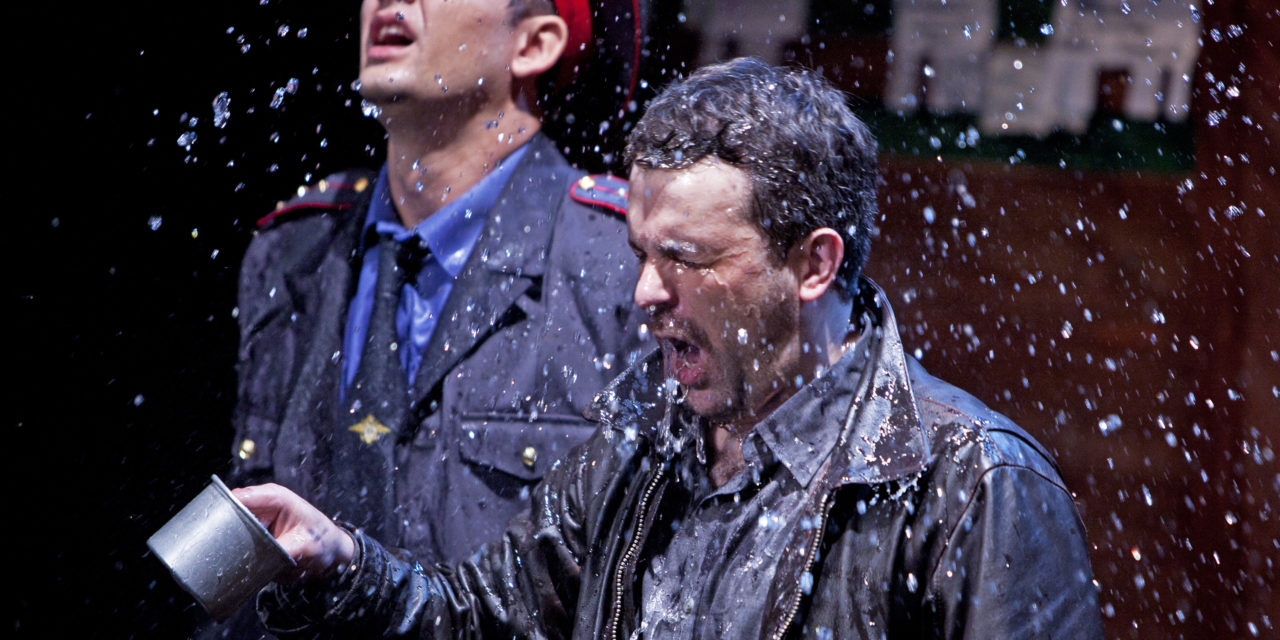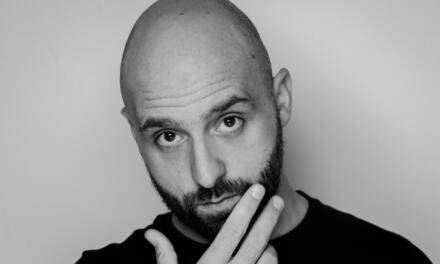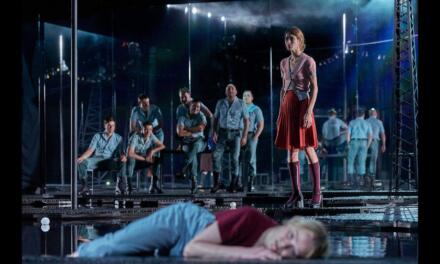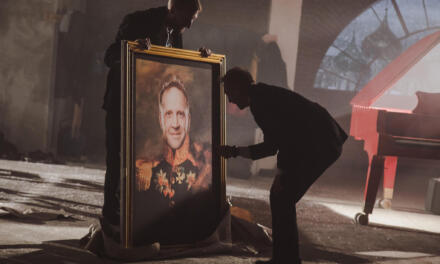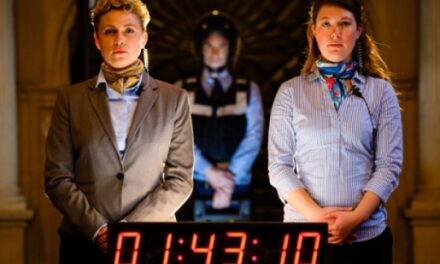The movement for the renewal of the repertoire and new playwriting in Russia is hardly more than fifteen years old. In that time a powerful network has been created, an infrastructure that covers Russia and the former Soviet republics. This network has become involved with the selection and cross-country distribution of plays; experimental work; the education of playwrights, directors, and actors in the new aesthetic; and the presence of the contemporary play in social networks. Today, dramaturgical life is both highly saturated and fiercely active. Seminars, laboratories, readings, student performances, festivals, discussions, and competitions extend across all of Russia, significantly influencing the theatrical climate of the country. There is a living reaction, a rebirth of the community, direct contact with spectators. And there is a conception of theatre as a dialogue in the literal sense of the word, as an agon, in which the most alarming problems of contemporaneity are debated. The spectators’ discussion teaches us that the new art reflects the unpleasantness of contemporary reality, which hides behind the unpleasantness of its art. In this reality of the Russian theatre, one of change and transition, the dramaturgical function is vital.
“Dramaturgs” in the German sense of the word do not exist in Russia. The Russian word dramaturg indicates the person who writes plays, not necessarily an affiliate of the theatre. Literary functions in the theatres are usually undertaken by the so-called zavlit (literary manager) or the associate artistic director. Russia, unfortunately, lacks a form of artistic residency for the dramatists inside the theatrical organism, but I am not dismissing the possibility that this Western experiment may be applicable to us in the near future. The need has now become urgent in that, as a rule, the question of the evolution of the dramatist (dramaturg) in Russia is to a great extent a question of the close collaboration between author and theatre. The techniques of the postdramatic theatre are already appearing in Russia, and the dramatist’s work is more and more frequently demanded in adaptation, the rewriting of classic texts, and literary assemblage.
The ethical atmosphere of today’s Russia is extremely complex. We have lived twenty years outside of the Soviet order, but just as before we have not fully organized our conception of reality, not named that country in which we now live, not finished constructing it. An important motif of contemporary Russian life was recently recorded in Transfer (dir. Vladimir Pankov), a notable performance piece based on the work of contemporary playwrights. It is set in a pedestrian underpass, which links one side of the street with the other, as individuals stand still for a long while: a holdup in the day that is life, the impossibility of turning backwards and the fear of coming out. The performance ends with a moment of triumph, as all the characters (around 40 people) go up to the forestage and sing a grand anthem, in which the anthems of tsarist Russian, the USSR, and the new Russia are all blended together. For those who do not know, I’ll explain: the melody of the new anthem partially coincides with the Stalinist, although some poet has rewritten the words. Here then is the spiritual state of the country: Russia can only rely upon something that exists in reality, a history that was truncated, “nullified” in the epoch of Lenin. To depend on the contemporary era is impossible because everything is unstable. Russia lives only insofar as its basic foundations, those laid in the Soviet system, continue to stand as they did back then. But the problem is that these foundations are decaying, if they are not already completely decrepit. There is nothing, or almost nothing, that is new. Putin’s Russia – especially in his second and third terms – raises the question of the rebirth of the Stalinist system, the rebirth of Sovietism. This historical preamble will be very important to keep in mind when we talk about the aesthetics of the new play.
The problem of contemporary play development is many layered. The last surge of new drama in Russia before the fall of the USSR was in the era of Perestroika. All at once, censorship collapsed, we discovered texts previously banned from the stage, theatrical life was decoupled from the state, and some of our most brilliant playwrights found themselves “liberated”: Lyudmila Petrushevskaya, Vladimir Sorokin, Aleksei Shipenko, Venedikt Yerofeyev. On the one hand, this was a playwriting of pain and despair. The plight of Soviet man was suddenly revealed: the automatism of his existence, the dislocation of his consciousness, the mundane routine of daily life, the savagery. Yet, on the other hand, these were the first experiments of postmodern deconstruction: the Soviet style turned into pop art and the related Sots Art (Socialist Art); and the Soviet mythology was imposed on the colossal cultural legacy of pre-revolutionary Russia, begetting freaks of nature, waxworks, and the insanity of an era in which the empire broke up and came to ruin. Following the fall of communism, dramatists began organizing various forms of social activity; they were called upon to defend the honor of their genre and simply to shout: “We are here.” The problem of the 1990s was also one of communication, which is crucial in our vast country. All the Soviet connections were in flames, books stopped being published, but the internet did not yet exist. Therefore, there was a pervasive need to inform all the theatres of Russia about the new plays, the new points of view.
And then came silence. In the history of the theatre, the 1990s began as years of stagnation: the crisis of financing and administration, the drainage of spectators (above all, the intellectuals, for whom theatre had been a beacon of liberal ideas, but the democratic spectators as well), the growth of the bourgeoisie, the gutterization of the repertoire. And due to several factors, the link between the theatre and dramatic literature snapped. First, the mechanism for circulating plays through the theatres vanished. The internet did not yet exist (although since the 2000s it has been the main propulsive force of the contemporary play in the Russian world), and the theatre journals ceased publication. For the vast, fragmented country without stable lines of communication, this fact led to the widespread claim: “we have no contemporary play.” Second, Soviet playwrights ceased writing overnight. If they did still write, it was with a lost sense of time: reality had been so abruptly exchanged, and it was still changing every day. Some other sort of brains and methods were needed to nail down this world. But it was the spirit of the time that was the most important factor in the parting of the theatre and the new play. The contemporary character vanished from theatrical productions, as stagings of classical prose became the phenomenon of the 1990s. It was precisely then that the celebrated theatre school of Petr Fomenko was cultivated and strengthened, a school famous for its particular method of theatrically realizing the prose through the irony of the narrator. Reality was terrible, criminal, hopeless, and unrecognizable – and so it completely vanished from the stage; the theatre did not wish to work on its own reflection in the mirror, and so it departed into nostalgia, dreams, and reveries.
The paradox of the Russian path towards a change in the repertoire and an interest in contemporaneity lies in the fact that it was the playwrights themselves who began the movement for renewal: having rallied together, the first post-Soviet generation began to campaign for the staging of new plays and the advancement of new drama into theatrical practice. This playwright-driven change is characteristic of Russian theatrical tradition. Russia is a literature-centric country, and the history of the theatre at all times has assumed that the playwright goes ahead of the process of change, writing his dream play rather than a text for the existing theatre. The playwright leads the theatre to change. And the theatre is reformed only through the word, through a sense of meaning, through logos. There has been extremely little nonverbal theatre in Russia up to now. The system of actor training is now, just as before, very dependent on the words and the established arrangement of performance roles. From the end of the 1990s to the start of the 2000s, many things were established for these dramaturgic populations: a whole network of mini-festivals, public readings of new plays, the electronic distribution of texts, discussions, and training seminars.
But there is a more complex aesthetic problem. Today, as never before, we see how Russian culture suffered under Soviet censorship, the system of prohibitions, and the cultural isolation of the era of communism. Today we see how the patriarchal theatre still struggles against contemporary culture, having armed itself with a system of taboos that was long ago overcome in the cinema and the art world. Theatre in Russia often resembles a museum or an archive of “eternal” values, which need to be protected from the dominating influence of contemporaneity. Because of the cultural isolation and censorship, Russian theatre could not pass through a crucial phase in the development of the European stage – the theatre of the absurd of the 1960s and 1970s. That style destroyed faith in scenic logic, in the logos, in life on the stage, in the meaning of the word, and in the linear construction of the plot.
Russian theatre did not pass through this essential stage of theatrical deconstruction. And therefore, Russian psychological theatre of the Chekhovian and Moscow Art Theatre type still prevails, inhibiting the experimental theatre. If we were to interrogate the society of today as to its cultural priorities, we would see that the majority would still name the Soviet phenomenon of art as a cultural ideal, full of virtue, harmony, imperial grandeur, and complacency. One significant topic arises in conversation with Western colleagues who have seen much Russian theatre: Russian theatre is painfully antisocial. It does not speak to the contemporary spectator, and it generally does not need the spectator, because the fourth wall stands in his place. Our theatre does not notice contemporaneity, its problems or psychoses. Our theatre is either nostalgic, or else it appears to be an anachronism. One of the strongest taboos of the stage is that it is considered bad form for art to be topical – it must speak about the eternal and the high-spiritual. The cultural legacy of Russia is so extensive, that the majority of the efforts of cultural establishments must be spent on maintenance and restoration. These establishments are essentially a part of the structure of the state’s cultural policy (we are frightfully dependent on the policy, since government sources account for three-quarters of the operating expenses of Russian cultural products). Very little place is devoted to contemporary art. The contemporary play is somehow optional. It may be in the repertoire, but it certainly does not have to be.
Strictly speaking, the contemporary playwriting movement is born in that moment when some sort of simple renewal of the repertoire is no longer enough, when it becomes imperative to put a contemporary person on the contemporary stage. When we need to understand our time, to name it and begin to contribute to it. The new play recognizes man’s need for self-identification, which is essential in order for him to function properly. The contemporary play in Russia is a manifestation of enormous social unrest, and even of social irritation. It lies in the field of inevitable societal conflicts. Contemporary playwrights do not care for the way things are going in the new Russia or the discomfort that they consider the norm. Theirs is a drama of pain, not of comfort. But above all, they understand the most important thing: in order to begin to work with reality, this world must be identified, named, perceived. Self-perfection begins with this gesture. The contemporary playwriting movement is an essential element in the renewal and rejuvenation of the Russian theatre. The most important result of the fifteen years of this resistance movement is that, together with the new play, a whole new generation has arrived on the scene: new directors, new ideas, new theatres, and most importantly the new spectator. Today it is widely accepted that a young director may enter the greater theatre world only through the staging of a new play. In fact, the practice of “double debuts” – when the young director makes his own debut with a new text in hand – has become firmly established. In other words, the playwrights began the reform of the theatre through the renewal of the texts, often incorporating cinematic elements. The contemporary text brought with it a series of problems, which were sooner or later resolved. At first, the spectator could not be found, so they cultivated him. Then the large theatres did not permit new texts, so they created small theatres. And when the system for distributing texts crashed down, they turned to the internet. And so forth.
The new play has raised a wave of public discussion about the theatre. Moreover, as a socially active art form, the new play resembles sociopolitical journalism, protest-oriented and broaching disputed issues – the new drama has returned a public significance to the theatre. This is above all due to the fact that it elicits dialogue from and arouses reactions in the spectator. Is it possible today to hope that the new phase of the theatrical experiment will depend on the text, on literature? All the same, how are young playwrights writing? And about what? The naturalistic verbatim style of documentary theatre prevails: a changeable reality demands the fixing of the reality that is slipping away, the fixing of the mechanics of life. The phenomenon of the contemporary play in Russia is for the most part a provincial occurrence. Among Muscovites and St. Petersburgians there are few playwrights. The playwrights mature outside the theatre, outside the institutions, spontaneously arriving to playwriting either with no experience, or with a harshly negative experience of the theatre, even having been scalded by the stage. The verbatim form offers both an apparatus and an excellent welcome for those who are writing their fifth or sixth text. It allows them to rise up and to break away from the experience of understanding oneself to the experience of understanding the other.
A pessimistic view is common to the new plays, as is extremely sharp dramatic effect, even tragedy – or rather, as in Nietzsche, tragic optimism. Comedies in Russia are simple, laughing. Not yet ready to part with the past, they instead take up the popular notion of the rebirth of the Soviet system. New drama is concerned with the subject of the little man, in this sense continuing the greater tradition of Russian literature. Its trajectory is extremely interesting: at first, the theatres of the capital city began to stage contemporary plays, and only today, towards the end of the first decade of the 2000s, has contemporary drama rolled over into the provinces. Now the provincial spectator and the regional theatres are the main “testing mechanism” for new plays. This is not a sign of the marginalization of the new play, but rather evidence of its profound evolution: the new play, which was written by provincials, returns home to finally appear to those to whom it was addressed. The themes of the provinces resound in the new play: lives in the provinces, psychological exploits, and the topic of survival, which has essentially replaced that of life. It is life that condemns the hero to martyrdom. The lives of the saints, hagiography. In the tense conflict between the individual and the chorus, the role of the unholy martyr is all that remains to the hero. Life does nothing but deceive us, and therefore it is no longer important to live life morally. We need simply to live, to survive. Ivan Vyrypaev’s play Oxygen confronts neopositivist values, while parodying and reinterpreting the Ten Commandments. The play’s protagonist maintains that we all live in the face of a future ecological or cosmic catastrophe, the final generation before the destruction of civilization. Essentially, the play states that it is important today to preserve our oxygen, the vanishing resource that is of singular importance for the safeguarding of life. A central motif in both Vyrypaev’s Oxygen and the Presnyakov brothers’ Playing the Victim is the renunciation of false national values and priorities. There is a sensation of openness in all parts of the world, and yet there are forces that drive you back into a cage: religion, the state, kitchen gossip, philistinism. Fear of society is characteristic for the hero of the contemporary play in Russia. There is a theme: the man and megalopolis, the man and mass communication, the effect of a totally open world on a person’s consciousness. There is the theme of antiglobalization, of the resistance to capitalism.
The new play conquers the taboos of society and the taboos of the theatre. In society there are three topics about which almost no one speaks: the demythologization of the Soviet soldier in World War II, the interfaith and international relations in Russia, and finally the topic of the church. Russia is becoming an increasingly clerical country, with the Orthodox church having entered into the government and its cultural policy. This connection has led to many prohibitions of theatrical productions, bans initiated by the church and supported by the authorities. Of course, there are no overtly antireligious plays in Russia. But there is another, even more pressing topic: the crisis of traditional faiths. Mankind stands on the eve of the creation of a new faith. Dissatisfied with Christianity, mankind demands new forms of worship, new symbols of faith. The contemporary play records this vast thirst for a genuine faith. And it shows the frightful and increasingly bloody journey to discovery. Man waits for the new Messiah, but he has not yet renounced the idea of sacrifice in the name of the new religion. Take for example the play The Polar Truth by Yury Klavdiev, who writes about new legends of urbanity. This play depicts members of the AIDS generation who live life as if they have begun humanity anew, a makeshift community of squatters disconnected from the outer world. The play treats AIDS as an illness that peels off layers of immunity – the history of mankind, its protective crust. As if nullifying history, it burns out everything false so as to bring the genuine out into the light.
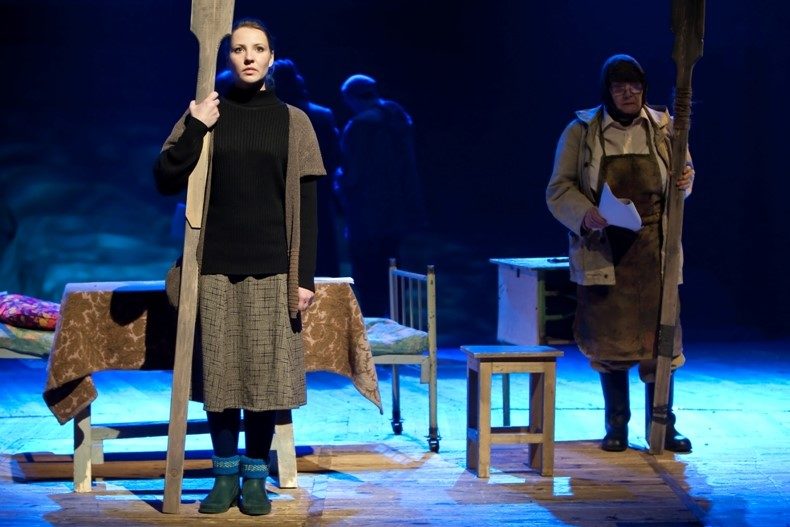
Natalia Moshina’s Rikotu Island, directed by Dmitry Yegorov at the Chekhov International Theatre Center, Yuzhno-Sakhalin. Photo credit: chekhov-center.ru/.
The theme of the provinces sounds brightly in two texts by Natalia Moshina and Vyacheslav Durnenkov. The protagonist of Moshina’s play Rikotu Island is a journalist from the capital who finds herself in the outskirts of Russia. It is an odd place in which people pray to shrimp and do not believe that Moscow is real. The protagonist sinks into the surrealistic abyss of the out-of-the-way place, which represents Russia as a country swept into a whirlpool of mysticism and irrationality. In Durnenkov’s play Exhibits (known in English as Frozen in Time), residents of a small dying town are faced with a dilemma: either to perish, proud and destitute, or to become museum exhibits of Old Russian culture, parading around the streets of an imaginary olden-times in ethnographic costumes. Traditional Russia is dying, the nation – especially the provinces – is becoming extinct, and traditional values are departing. To save them, one can either exit to the depths, there to vanish, or else become a museum, a tourist center.
The plays of the Presnyakov Brothers and Pavel Pryazhko develop the theme of a profound imitation of life, a life that is only “second-hand.” Pryazhko infuses his plays with a particularly striking sort of language. His stage directions lose their meaning and become part of the theatrical game, not so much explaining the actor’s behavior in the scene, as parodying his efforts to imitate human characteristics. Pryazhko’s play text demonstrates communication at an impasse: language is dying, no longer a means of transmitting meaning from person to person, and the lexicon is poor. Consciousness uses language to demonstrate its own shimmering instability.
One of the most recent to try his hand at the contemporary play is the young Dmitry Bogoslavsky of Belarus. His plays focus on the unsteady boundary separating reality from deceitful illusions, those psychological impasses where we are led by our consciousness, which cannot catch hold on reality. We cannot find anything which can help to keep us in the objective world, and imaginings appear to us as an ominous darkness, while frostbite and stupor gradually drive us back from reality. Here, if you will, is the hero of our time: vainly struck down for the right to stand firm in reality and lightly giving back its return ticket. Such was the subject of his play The Quiet Rustle of Disappearing Steps. And his play Love of People is a robust and sensual melodrama, with a hard and uncompromising edge. In it, love tortures people like a psycho-killer, infuriating them and driving them to unreasonable acts. Love is not pleasure; rather, it is despair, winter, grief. It is endless visions, hallucinations, illusions, whose attraction is as strong as the embrace of Morpheus. Every character in Love of People hovers in the emotional realm, “thrown” into passion like the humble linen thrown over the clothesline. Part-drug, part-nightmare, and part-dream, this emotionality displaces the very life of the characters. Love – and crises of love – seems to steal the very breath of life from a person. Love-death is given to us as martyrdom. Families and fortunes disintegrate, but the person is spellbound, still scrutinizing the creation of this phantom, dissolving in it completely.
In this sense the metamorphoses of the Russian play are interesting. A time of relative freedom – the end of the 1990s through the 2000s – has given birth to an interest in the new reality, in the documentation, the fixing, and the understanding of it. In the 2010s, when Russians have again begun to speak about the repressive mechanisms and the premature rollback of the liberal reforms, the playwright has appeared: speaking about the salvation to be found in illusion, the therapeutic effect of escapism, and of social phobia. Having begun to actively stage Dmitry Bogoslavsky, Russian theatres once again celebrate the idea of the wholesomeness of dreams and escaping into the world of intimate emotions.
Translated by Jessica Hinds-Bond. A shorter version of this article originally appeared under the title “The New Play Dramaturgy in Russia” in The Routledge Companion to Dramaturgy, ed. Magda Romanska (London: Routledge, 2015), 62-67. Reprinted with permission from Routledge and the author.
This post was written by the author in their personal capacity.The opinions expressed in this article are the author’s own and do not reflect the view of The Theatre Times, their staff or collaborators.
This post was written by Pavel Rudnev.
The views expressed here belong to the author and do not necessarily reflect our views and opinions.

